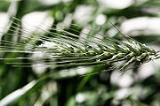
Awn
Encyclopedia

Botany
Botany, plant science, or plant biology is a branch of biology that involves the scientific study of plant life. Traditionally, botany also included the study of fungi, algae and viruses...
, an awn is either a hair- or bristle-like appendage on a larger structure, or in the case of the Asteraceae
Asteraceae
The Asteraceae or Compositae , is an exceedingly large and widespread family of vascular plants. The group has more than 22,750 currently accepted species, spread across 1620 genera and 12 subfamilies...
, a stiff needle-like element of the pappus
Pappus (flower structure)
The pappus is the modified calyx, the part of an individual disk, ray or ligule floret surrounding the base of the corolla, in flower heads of the plant family Asteraceae. The pappus may be composed of bristles , awns, scales, or may be absent. In some species, the pappus is too small to see...
.
Awns are characteristic of many grass
Grass
Grasses, or more technically graminoids, are monocotyledonous, usually herbaceous plants with narrow leaves growing from the base. They include the "true grasses", of the Poaceae family, as well as the sedges and the rushes . The true grasses include cereals, bamboo and the grasses of lawns ...
es (Poaceae
Poaceae
The Poaceae is a large and nearly ubiquitous family of flowering plants. Members of this family are commonly called grasses, although the term "grass" is also applied to plants that are not in the Poaceae lineage, including the rushes and sedges...
), where they extend from the lemma
Lemma (botany)
Lemma is a phytomorphological term used in botany referring to a part of the spikelet of grasses . It is the lowermost of two chaff-like bracts enclosing the grass floret. It often bears a long bristle called an awn, and may be similar in form to the glumes - chaffy bracts at the base of each...
s of the florets. They often make up the hairy appearance of the grass synflorescence. Awns may be long (several centimeters) or short, straight or curved, single or multiple per floret. Some genera are named after their awns, such as the three-awn
Three-awn
The three-awns are the grass genus Aristida, distinguished by having three awns on each lemma of each floret. The genus includes about 300 species, found worldwide, often in arid warm regions...
s (Aristida).
In some species, the awns can contribute significantly to photosynthesis, for example barley
Barley
Barley is a major cereal grain, a member of the grass family. It serves as a major animal fodder, as a base malt for beer and certain distilled beverages, and as a component of various health foods...
.
The awns of wild emmer
Emmer
Emmer wheat , also known as farro especially in Italy, is a low yielding, awned wheat. It was one of the first crops domesticated in the Near East...
wheat spikelets effectively self-cultivate by propelling themselves mechanically into soils. During a period of increased humidity during the night, the awns of the spikelet become erect and draw together, and in the process push the grain into the soil. During the daytime the humidity drops and the awns slacken back again; however, fine silica hairs on the awns act as hooks in the soil and prevent the spikelets from reversing back out again. During the course of alternating stages of daytime and nighttime humidity, the awns' pumping movements, which resemble a swimming frog kick
Frog kick
The frog kick is a swimming action sometimes used by scuba divers when they are swimming near a soft silty seabed or lakebed which they do not want to stir up damaging the visibility. It is like the swimming action of a frog or the leg part of the breaststroke...
, drill the spikelet as much as an inch into the soil.

